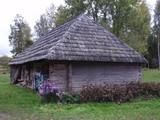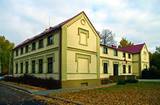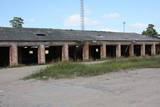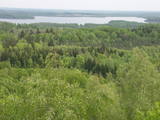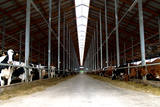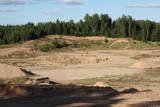| Nr | Name | Beschreibung |
|---|---|---|
|
This is the home of singer and oral tradition keeper Lidija Jansone, who is a holder of the Latvian Order of Tree Stars and a fierce defender of the cultural heritage of the Suiti people. She will tell you about her community’s history and traditions and about the special bourdon singing of the Suiti. Lidija will also talk about how beer was once brewed by our ancestors for various celebrations. |
||
|
In 1888, the building, provided for a doctor’s needs, was donated by Baron Alexander Alexei von Pistohlkors to the parish of Pēterupe Lutheran Church. Along with the building, Baron Pistohlkors also donated 6 hectares of land and 10 000 roubles for the doctor’s use. Arvēds von Engelhards became the first medical doctor in Pēterupe. In 1890, the first pharmacy was opened in one room of the clinic, serving people from a wide area; it remained in the building until 1895. This outpatient clinic was the very first stone building in Saulkrasti, the first health authority in a wide area, as well as the first pharmacy. Through its entire lifetime, the house was maintained from voluntary donations – at first by Alexander Alexei von Pistohlkors, then by churchgoers of Pēterupe Parish – therefore by the money of the villagers. |
||
|
In der Zeit der Sowjetunion befand sich in der Abteilung der Panzer ein Lehrregiment. Heutzutage ist das Objekt degradiert und bewirtschaftet werden nur die Gebäude der Renovierung und die wirtschaftlichen Gebäude der ehemaligen Abteilung der Panzer. Das übrige Territorium wird nicht genutzt und es ist nicht bewacht.
|
||
|
Dieses Territorium soll die Hügel und Seen des Hochlandes von Augšzeme schützen – die Seen Svente, Medums, Ilga und andere mit ihren Inseln, Landschaften und Arten. Der Naturpark, der um die Seen Svente und Medums herum eingerichtet wurde, ist Teil dieses Territoriums und es gibt mehrere Gebiete, die aus Umweltgründen geschützt werden – die Seen Bardinskis und Skujine und die Inseln der Seen Medums und Svente. Es gibt einen Aussichtsturm auf dem Egļukalns - Berg und Abfahrtsski-Routen.
|
||
|
1.2 km to the south of the centre of Ģipka and on the side of the Jūrmala-Kolka road (P131), this church makes it hard to believe that the rock church was built very recently – after 1992, because it was burned down during the Soviet occupation in 1979. Ironically, the Dundaga forestry fire safety post was housed in the steeple of the church after World War II. The ornate altar and organ were destroyed in the fire, but the altar painting, “Christ on the Cross,” was saved. The church is now once again open for business. |
||
|
Kuģinieku drošībai 1875. g. celtā bāka stipri cieta 1. pasaules kara laikā. Savu tagadējo izskatu tā ieguva pēc atjaunošanas 1922. g. Bākas uguns atrodas 21,3 m v.j.l. un tās detaļas savulaik vestas no Francijas. Pie bākas ieejas 1975. g. uzstādīta piemiņas plāksne par godu bākas simtgadei. Pie bākas atrodas bijušās padomju armijas militārās bāzes atliekas. |
||
|
Wenn man am nördlichen Ufer des Sees von Sauka (wo die Kreuzung nach Klauce ist) fährt, kann man die von Bäumen umsäumte evangelisch-lutherische Kirche von Sauka sehen. Das heutige Gebäude ist das dritte Gotteshaus an dieser Stelle. Es wurde im Jahr 1827 eröffnet und es ist hauptsächlich von außen zu besichtigen. Der Altar der Kirche ist mit den Skulpturen der Apostel Peter und Paul und mit dem Altargemälde von Julius Döring Christus am Kreuz mit Maria und Johannes geschmückt. Die Orgel haben Meister aus Jelgava, aber die Pfeifen – Meister aus Sauka hergestellt. |
||
|
Die Agrofirma Tērvete AG ist das größte Mehrzweigunternehmen für Landwirtschaft in Lettland, das sechs Bereiche umfasst: Obstbau, Milchviehzucht, Pferdezucht, Verpflegung, Biogasherstellung und Bierherstellung. |
||
|
Darbnīcā tiek izgatavoti personalizēti pulksteņi un dažādi dizaina priekšmeti no koka, kā arī piedāvātas kokapstrādes meistarklases vai klātbūšana dažādos materiāla pirmsapstrādes vai finiša apstrādes procesos. Tāpat iespējama ekskursija pa darbnīcu un koku sugu atpazīšanas viktorīna. |
||
|
Ļoti savdabīga vieta, ko nekādi nevar dēvēt par tūrisma objektu. Vidsmuiža bija viena no Latgales lielākajām muižām, kuras dominante bija 18. gs. celtā un vēlāk pārbūvētā grāfu Borhu muižas kungu māja. Tagad redzamais muižas kompleksa veidols tapis 19. gs. otrajā pusē. Tajā ietilpst kūtis, staļļi, kalpu māja, klētis, sarga mājiņas, kas izvietotas ap parādes pagalmu. Pēdējais tagad ir stipri aizaudzis. Vecākā saimniecības ēka ir mūra klēts (iespaidīga!), ko cēla 18. gs. Regulāra plānojuma muižas parku veidoja 18. gs. franču dārzu stilā. Kungu māja ir „pamesta” un apskatāma tikai no ārpuses. |
||
|
Dies sind Hügel im nördlichen Ende des Vidzemer Hochlandes. Sie sind ein wichtiges Gebiet für den Nördlichen Nadelwaldgürtel und seine Sümpfe. Hier werden verschiedene Sumpfarten gefunden, sie sind Heimat einer Anzahl wirbelloser Tiere.
|
||
|
The tower on the eastern shore of Lake Engure (next to the meadow for wild cattle, accessible from the side of Bērzciems) offers a view of the reeds, small islands, Great Island, cows and horses of the north-eastern part of the lake. The tower on the northern shore of the lake (accessible from the side of Mērsrags) offers a look at the boating facility and the very overgrown northern part of the lake. The tower at the north-western shore of the lake (accessible from the side of Ķūļciems) shows the Apaļrova island (a footpath), stands of juniper, the boating facility, and the mosaic-like landscape of the lake itself.
|
||
|
Šis ir viens no 6 ceļojuma maršrutiem sērijā "Baudi laukus!", un tas aicina apmeklēt Lauku Labumus – visdažādāko veidu un nozaru saimniecības un uzņēmumus, kas atvērti apmeklētājiem, piedāvā ekskursijas, nogaršot, apskatīt un iegādāties savus ražojumus. Tur apskatāmi mājdzīvnieki, mūsdienīgas lauku saimniecības, amatnieku darbnīcas, iegādājami lauku produkti – maize, medus, mājas vīns un alus, siers, ogas, augļi, zivis, gaļa, dārzeņi, tējas un citi laukos audzēti labumi. Pa ceļam iespējams ieturēt pusdienas lauku krodziņos. |
||
|
Atrodas pie Līvānu dzelzceļa stacijas, Dzelzceļa ielā 17. Tā kā Līvānos nebija luterāņu baznīcas, draudze dievkalpojumus noturēja ugunsdzēsēju depo. 1929. gadā ielika dievnama pamatakmeni un pēc trīs gadiem pabeidza pašas ēkas celtniecību. Saglabājušās ziņas, ka padomju laikā baznīcā bija plānots iekārtot sporta zāli un noliktavu, taču tas neticis īstenots. Jāpiemin, ka baznīca ir celta uz bijušās korķu fabrikas pamatiem. Dievnama zvana iegādei līdzekļus sarūpēja kara ministrs – ģenerālis Jānis Balodis u.c. |
||
|
Ein gastfreundliches und gemütliches Café im Zentrum von Alūksne mit einer vielfältigen Küche für jeden Geschmack. Darüber hinaus werden auch Spezialitäten der Region Alūksne zubereitet: Salat „Tempelberg“, Hauptgericht „101 Stufen bis zum Genussmoment“ und Dessert „Inseln des Marienburger Sees”. Es werden Geschäftsessen und spezielle Monatsangebote sowie ein Kindermenü angeboten. |
||
|
Ein neues Cafe, das sich auf dem Gelände des Naturparks „Daugavas loki” in Naujene befindet. |
||
|
Der Wirt hat am Hang des Flusses Abuls das erste Mal in Lettland (1996) angefangen, amerikanische Heidelbeere zu züchten. Jetzt grünen hier weite Felder mit diesen Beeren. Verkauf von Beeren und Setzlingen, Führung mit Verkostung und Beratung, Garteneinrichtung und Planung von Grünanpflanzungen. |
||
|
Die in 1991 vom Bildhauer Ojārs Feldbergs auf den Plätzen der ehemaligen Landgüter Firkspedvāle und Briņķpedvāle am rechten Ufer des Abava-Urstromtals gegründete Freilichtausstellung der Kunstwerke. Das einzige Objekt solcher Art in Lettland. |
||
|
Die Pflanzenbau – und Bienenzuchtwirtschaft befindet sich am Ufer des Flusses Amata. In der Wirtschaft werden Nektarpflanzen wie Fazelien, Weißer und Gelber Honigklee angebaut und 150 Bienenvölker gepflegt. Verkostung und Erwerb der Produktion, Bestellungen, Beratung, Organisation von Seminaren. Der einzigartige Buchweizen-Kleehonig, Anfertigung von Wachskerzen- und Figuren.
| ||
